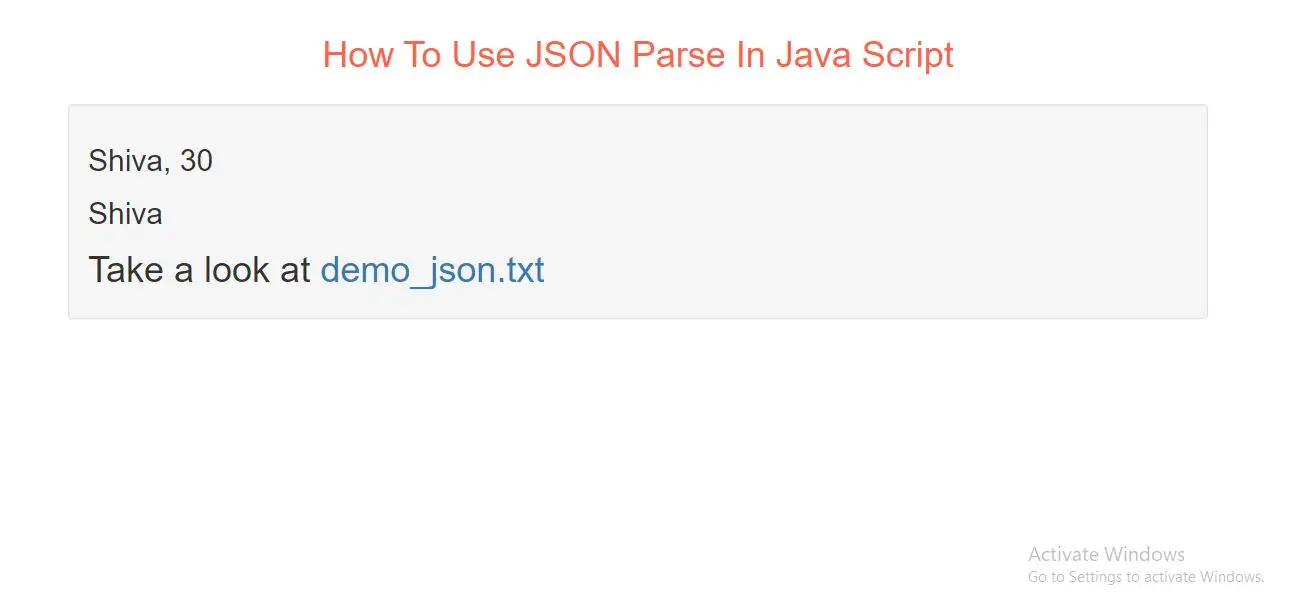
When receiving data from a web server, the data is always a string.
Parse the data with JSON.parse(), and the data becomes a JavaScript object.
Example - Parsing JSON
Imagine we received this text from a web server:
'{ "name":"Shiva", "age":30, "city":"New York"}'
Use the JavaScript function JSON.parse() to convert text into a JavaScript object:
var obj = JSON.parse('{ "name":"Shiva", "age":30, "city":"New York"}');
Make sure the text is written in JSON format, or else you will get a syntax error.
Use the JavaScript object in your page:
<h2 id="demo1"></h2>
<script>
var txt = '{"name":"Shiva", "age":30, "city":"New York"}'
var obj = JSON.parse(txt);
document.getElementById("demo1").innerHTML = obj.name + ", " + obj.age;
</script>
JSON From the Server
You can request JSON from the server by using an AJAX request
As long as the response from the server is written in JSON format, you can parse the string into a JavaScript object.
Use the XMLHttpRequest to get data from the server:
var xmlhttp = new XMLHttpRequest();
xmlhttp.onreadystatechange = function() {
if (this.readyState == 4 && this.status == 200) {
var myObj = JSON.parse(this.responseText);
document.getElementById("demo1").innerHTML = myObj.name;
}
};
xmlhttp.open("GET", "demo_json.txt", true);//create file with json data
xmlhttp.send();
Array as JSON
When using the JSON.parse() on a JSON derived from an array, the method will return a JavaScript array, instead of a JavaScript object.
The JSON returned from the server is an array:
var xmlhttp = new XMLHttpRequest();
xmlhttp.onreadystatechange = function() {
if (this.readyState == 4 && this.status == 200) {
var myArr = JSON.parse(this.responseText);
document.getElementById("demo").innerHTML = myArr[0];
}
};
xmlhttp.open("GET", "json_demo_array.txt", true);
xmlhttp.send();
Exceptions
Parsing Dates
Date objects are not allowed in JSON.
If you need to include a date, write it as a string.
You can convert it back into a date object later:
Convert a string into a date:
var text = '{ "name":"John", "birth":"1986-12-14", "city":"New York"}';
var obj = JSON.parse(text);
obj.birth = new Date(obj.birth);
document.getElementById("demo").innerHTML = obj.name + ", " + obj.birth;
Or, you can use the second parameter, of the JSON.parse() function, called reviver.
The reviver parameter is a function that checks each property, before returning the value.
Convert a string into a date, using the reviver function:
var text = '{ "name":"John", "birth":"1986-12-14", "city":"New York"}';
var obj = JSON.parse(text, function (key, value) {
if (key == "birth") {
return new Date(value);
} else {
return value;
}
});
document.getElementById("demo").innerHTML = obj.name + ", " + obj.birth;
Parsing Functions
Functions are not allowed in JSON.
If you need to include a function, write it as a string.
You can convert it back into a function later:
Convert a string into a function:
var text = '{ "name":"John", "age":"function () {return 30;}", "city":"New York"}';
var obj = JSON.parse(text);
obj.age = eval("(" + obj.age + ")");
document.getElementById("demo").innerHTML = obj.name + ", " + obj.age();
Complete Code For JSON Parse In Java Script With Examples
<!DOCTYPE html>
<html>
<head>
<title>How To Use JSON Parse In Java Script </title>
<meta charset="utf-8">
<meta name="viewport" content="width=device-width, initial-scale=1">
<link rel="stylesheet" href="https://maxcdn.bootstrapcdn.com/bootstrap/3.4.1/css/bootstrap.min.css">
</head>
<body>
<div class="container">
<br>
<div class="text-center">
<h1 id="color" style="color: tomato">How To Use JSON Parse In Java Script</h1>
</div>
<br>
<div class="well">
<h2 id="demo1"></h2>
<h2 id="demo2"></h2>
<h1>Take a look at <a href="demo_json.txt" target="_blank">demo_json.txt</a></h1>
</div>
<script>
var txt = '{"name":"Shiva", "age":30, "city":"New York"}'
var obj = JSON.parse(txt);
document.getElementById("demo1").innerHTML = obj.name + ", " + obj.age;
//example2
var xmlhttp = new XMLHttpRequest();
xmlhttp.onreadystatechange = function() {
if (this.readyState == 4 && this.status == 200) {
var myObj = JSON.parse(this.responseText);
document.getElementById("demo2").innerHTML = myObj.name;
}
};
xmlhttp.open("GET", "demo_json.txt", true);//create file with json data
xmlhttp.send();
</script>
</div>
</body>
</html>